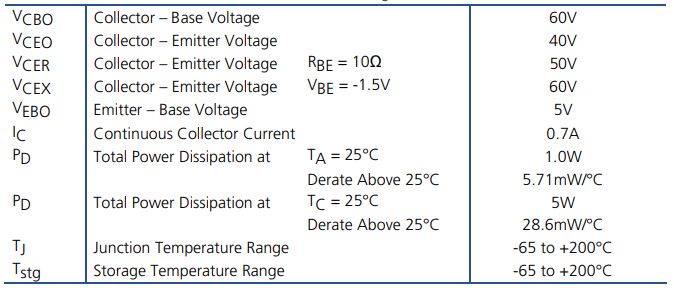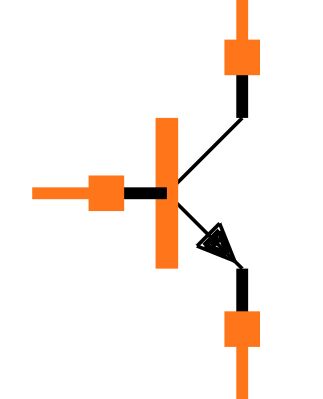By Central Semiconductor 168
2N3053 is a common NPN-type bipolar transistor, which is commonly used in amplification and switching applications in electronic circuits. This transistor has two pins, namely Emitter, marked E, Base, marked B, and Collector, marked C.
In the 2N3053 transistor, current mainly flows between the base and emitter, while the main role of the collector is to collect electrons. This transistor can be used as an amplifier or switch in a circuit, and its working principle can be controlled by the voltage at the base. When the base voltage reaches a certain threshold, the transistor turns on, allowing current to flow freely between the emitter and collector. When using this transistor, parameters such as its maximum voltage, maximum current, and maximum power need to be considered to ensure that it can work safely and effectively in the circuit.
2N3053 can use a single DC power supply and is usually used in circuits such as low-noise amplifiers, signal amplifiers, DC-DC converters, voltage regulators, voltage comparators, pulse generators and switches. It is also used by many students and enthusiasts to learn electronics. One of the introductory transistors to learn.
Ⅰ.Specification parameters of 2N3053
•Installation style:Through Hole
•Package/Box:TO-39-3
•Transistor polarity:NPN
•Configuration:Single
•Collector-emitter maximum voltage VCEO:40V
•Collector-base voltage VCBO:60V
•Emitter-base voltage VEBO:5V
•Collector-emitter saturation voltage:1.7 V
•Pd-Power dissipation:5W
•Gain bandwidth product fT:100 MHz
•Minimum operating temperature:-65℃
•Maximum operating temperature:+200℃
•Collector continuous current:700 mA
•Base Gain hfe Min:50 at 150 mA, 10 V
•DC current gain hFE maximum:250 at 150 mA, 10 V
•Product type:BJTs-Bipolar Transistors
•Number of pins:3
Ⅱ. Working principle of 2N3053
1.Structure: The 2N3053 transistor has three stacked semiconductor regions, namely Emitter, Base and Collector. These regions are separated by different types of semiconductor materials.
2.Basic working principle
•Current control: When the voltage applied between the base and emitter reaches a certain threshold, a small current starts to flow in the base (base current). This base current controls the much larger current from the emitter to the collector (collector current). This behavior is called "current control".
•Semiconductor materials: NPN bipolar transistors are composed of three different types of semiconductor materials. These three semiconductors are N-type semiconductor, P-type semiconductor and N-type semiconductor. N-type semiconductors are often called electron-conducting materials, while P-type semiconductors are often called hole-conducting materials.
•Amplification: Due to the control of the base current on the collector current, 2N3053 can act as an amplifier. By changing the voltage applied between the base and emitter (thereby changing the base current), the collector current can be changed to achieve signal amplification.
•Switch function: 2N3053 can also be used as a switch. When the voltage applied between the base and emitter is very low (much lower than the turn-on voltage), the transistor is in an "off" state and almost no current flows through it. When the voltage applied between the base and emitter reaches the turn-on voltage, the transistor is in the "on" state, and the current from the emitter to the collector can be very large. Therefore, by controlling the voltage applied between the base and emitter, the switching function of the transistor can be achieved.
Ⅲ.Asolute Mximum Rtings for 2N3053(Tc=25℃ unless otherwise stated)

IV.2N3053 pin configuration


•Pin 1:Emitter, usually labeled E, is where current enters the transistor. Electrons enter from the emitter and flow to the base.
•Pin 2:Base, usually labeled B, is the pin that controls the transistor. By applying current or voltage to the base, the flow of current from the emitter to the collector can be controlled.
•Pin 3:Collector, usually labeled C, is where the current is taken from the transistor. Electrons flow from the base to the collector, forming an output current.
V.Main applications of 2N3053
2N3053 can be used for various purposes in different electronic applications such as low power audio amplifiers, power supply circuits and various other electronic applications. Due to its high switching frequency of up to 100MHz, it can also be used in applications requiring higher frequencies as well as radio and RF applications.
1.Amplifier
2N3053 is often used to amplify small signals. It can be used in amplifier circuits to augment audio signals, RF signals, and other types of signals.
•Audio amplifier: 2N3053 is the most widely used in audio amplifiers. It can be used as an audio signal amplifier to amplify weak audio signals so that they can drive speakers or other audio output devices to produce clearer and louder audio.
•RF amplifier: 2N3053 can also be used to amplify RF (radio frequency) signals. In applications such as wireless communications, radar and radio frequency identification, weak RF signals need to be amplified to achieve signal transmission and processing. The high switching frequency of the 2N3053 (up to 100MHz) makes it ideal for these applications.
•Amplification of other types of signals: In addition to audio and RF signals, 2N3053 can also be used to amplify various types of small signals, such as weak signals output by sensors, light signals, etc. By adding it to the corresponding circuit, the amplification and processing of these weak signals can be achieved.
2.Switch circuit
2N3053 can be used in switching circuits to switch large current circuits by controlling the base current. This is useful in digital logic circuits and in control circuits.
When the current applied to the base of 2N3053 is large enough, the transistor will conduct, allowing large current to pass through the collector and emitter. When the current applied to the base is small, the transistor will remain closed, preventing large currents from passing through. Therefore, the large current of the collector can be controlled by changing the base current to realize the switching function.
In digital logic circuits, this switching behavior can be used to build basic logic gates, such as AND gates, OR gates, NOT gates, etc. For example, two 2N3053 diodes can be connected together to form an AND gate. When both inputs are high, both transistors are turned on and the output is high. When either input is low, the output is low.
In the control circuit, the 2N3053 transistor can also play the role of switch. For example, it can be used to control the action of a relay, or control the speed of a DC motor, etc. By changing the current applied to the base, the opening and closing speed of the switch can be changed, thereby achieving different control effects.
3.Voltage regulator
The 2N3053 can be used to build voltage stabilizer circuits to help stabilize the output voltage to meet the power requirements of a specific application.
2N3053 transistors can be used to build voltage regulator circuits. A voltage regulator is an electronic device that provides a stable output voltage even if the input voltage or load changes. This is usually accomplished by regulating the base current of the transistor. In a voltage regulator circuit, the 2N3053 transistor is used as an amplifier to amplify changes in input voltage to drive a regulating element (such as a power transistor or a servo motor). The adjusting component will adjust its own working state according to the output signal of the transistor, thereby changing the output voltage.
By selecting the appropriate resistors and capacitors, the regulator's output voltage can be set to meet the power requirements of a specific application. This kind of voltage regulator circuit is usually used in fields such as power supply, electronic equipment and control systems to ensure a stable supply of power voltage.
4.Voltage amplifier
2N3053 can also be used in voltage amplifier circuits to amplify voltage signals.
5.Drive
The 2N3053 can be used as part of a driver for other electronic components or circuits to ensure they function properly. The 2N3053 transistor can be used as a driver to drive other electronic components or circuit parts. The transistor has the function of current amplification, which can input a smaller current through the base and output a larger current through the collector. Utilizing this feature, the 2N3053 can be used as a current source to drive other electronic components.
When the 2N3053 transistor is used as a driver, the appropriate circuit connection method needs to be selected according to the specific application. A common connection method is to use a common emitter amplifier circuit to input the input signal into the triode through the base, and amplify the signal through the amplification of the triode to drive the subsequent circuit.
Ⅵ.2N3053 alternative model
1.2N3904: 2N3904 is a commonly used NPN bipolar transistor with characteristics such as current amplification and switching circuits. It is widely used in various applications, including amplifiers, switching circuits and oscillators. When the current of the base of 2N3904 is large enough, it can amplify the current of the input signal and achieve signal amplification. It can also control the on and off of the transistor by controlling the current added to the base of 2N3904, thereby realizing the function of the switching circuit.
2.2N2222: 2N2222 is another common NPN-type bipolar transistor used in various electronic applications, including amplification, switching, and oscillator circuits.
3.BC547: BC547 is also a common NPN bipolar transistor suitable for many amplification and switching applications.
4.2N3906: If a PNP bipolar transistor is needed as an alternative, the 2N3906 is a common choice.
5.2N4401: The 2N4401 is another common NPN-type bipolar transistor suitable for similar applications and can often replace the 2N3053.
Frequently Asked Questions
1.What type of transistor is the 2N3053?
The 2N3053 is a silicon NPN transistor packaged in a TO-39 metal can. This type of enclosure is primarily designed for amplifier and switching applications. The device has high breakdown voltage, low leakage current, low capacity, and beta characteristics that can be used over a very wide current range.
2.What is the maximum operating frequency of 2N3053?
The maximum operating frequency of the 2N3053 is usually in the range of tens of megahertz (MHz) to hundreds of megahertz (MHz).
3.What are the temperature characteristics of 2N3053?
Temperature changes will affect the current amplification of the 2N3053, usually causing its amplification to change slightly. When the 2N3053 is working, part of the electrical energy will be converted into heat energy, causing the transistor to heat up. As the temperature rises, its internal temperature affects the current and voltage characteristics.